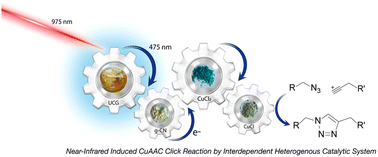Geared photochemistry: an interdependent heterogeneous near-infrared catalytic system using up-conversion glass and g-CN for CuAAC chemistry†
Abstract
From the synthesis of small biomolecules to complex macromolecular structures, click chemistry is one of the most promising and straightforward methodologies owing to its easy accessibility and high efficiency. A dual-heterogeneous photocatalyst with the capability of engendering light emission in upconversion materials combined with graphitic carbon nitride (g-CN) could present a powerful tool in electron transfer reactions, specifically in copper-catalyzed azide–alkyne cycloaddition (CuAAC) click reactions. We herein describe a “geared photochemistry” approach for producing an electron from g-CN by in-source lightening in the near-infrared region using upconversion glass that produces copper(I) to initiate the click reaction. Using this approach, the photocatalytic activation of g-CN has been achieved by using Tm3+ and Yb3+ ion-doped zinc-tellurite glass which absorbs laser irradiation at 975 nm and is capable of emitting blue light at 475 nm. The efficiency of this system has been investigated for various CuAAC reactions ranging from small molecule synthesis to the macromolecular scale including modification strategies of polymers.



 Please wait while we load your content...
Please wait while we load your content...